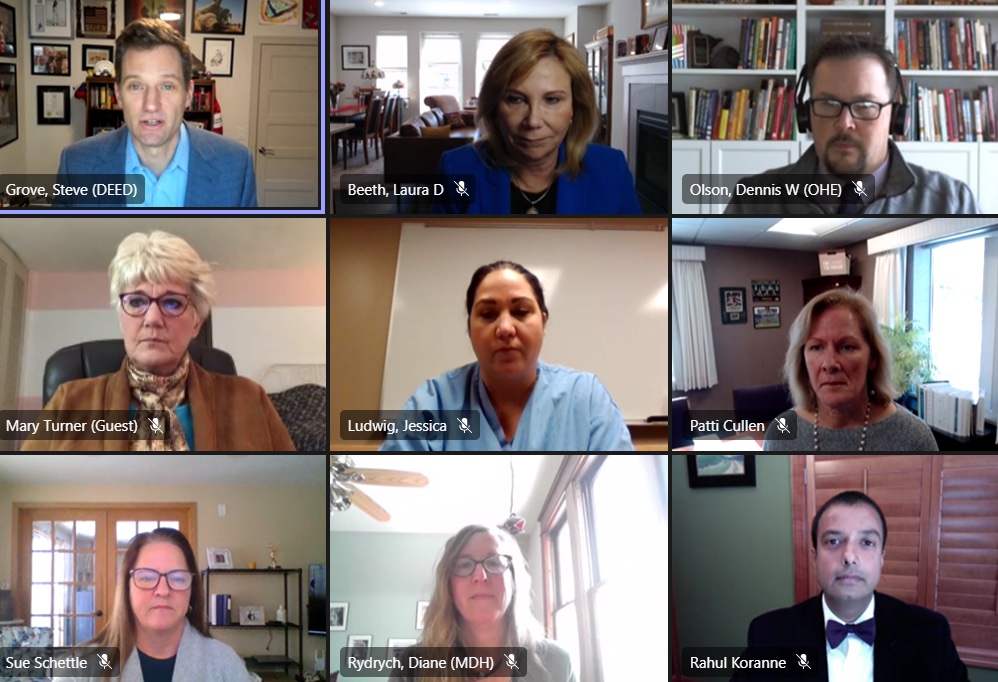1/7/2022 3:27:37 PM
Commissioner Steve Grove

I was honored to lead a robust roundtable discussion yesterday featuring representatives of the hospital, long-term care, and disability services industries, along with labor, employer and worker representatives, as well as leaders of the Minnesota Departments of Employment and Economic Development, Education, Health, Human Services, and the Office of Higher Education. We engaged in a very candid, hopeful, and I would even say inspiring discussion about the health care workforce shortage and what can be and is being done about it.
The workforce shortage is affecting nearly all parts of the nation’s economy right now. But not having enough health care workers is a matter of life and death. Our unprecedented health care workforce shortage has a real impact – not only on people providing care, but also on those receiving it.
With just under 40,000 vacancies in the latest job vacancy survey, health care positions accounted for nearly one in every five job vacancies in Minnesota – the largest number of unfilled positions of any industry in the state. But it’s not just today’s health care workforce needs we need to be concerned about – Minnesota is projected to add more than 80,000 new health care jobs over the next decade.
January is Health Care Month, a month dedicated to raising awareness about the many employment opportunities in health care and sharing the word about how fulfilling the caregiving professions are.
Here are messages some of health care participants shared to encourage more Minnesotans to work in health care now:
“We need you,” said Dr. Rahul Koranne President & CEO of the Minnesota Hospital Association and a medical doctor “It’s a wonderful industry to work in, I am in it and I can tell you from experience you will find joy. Come join us.”
“Working with people with disabilities fills your heart,” said Sue Schettle, CEO of ARRM, an organization that represents providers of services to Minnesotans with disabilities.
“There is no better profession than the caring profession because no matter how difficult it gets, you can always say you have a job that makes a difference,” said Mary Turner, President of the Minnesota Nurses Association.
“This is a career where you will use your heart and your head every day” said Laura Beeth, Vice President of Talent Acquisition, M Health Fairview and Chair of the Governor’s Workforce Development Board.
“It’s your ticket to heaven,” said Patti Cullen, President & CEO of Care Providers of Minnesota, which represents senior and other long-term care providers in Minnesota.
Roundtable participants shared their challenges providing care during the health care workforce shortage – and how the recent surge in COVID-19 cases has again put enormous stress on all those in the caregiving professions. Leaders of state agencies participating on the panel outlined what is being done to address the immediate crisis as well as what will need to be done to take on the larger health care workforce shortage issue, which pre-dates the pandemic in many settings.
“During the Omicron surge, we’ve already done some additional supports for nursing homes and we’re talking with group homes serving people with disabilities and we’ve been doing all we can to transfer patients out of hospitals into our direct care and treatment services. We’re looking for fast on-the-ground creativity now and we’ll be looking for long-term creativity working together going forward,” said Jodi Harpstead, Commissioner of the Minnesota Department of Human Services. “We’ll be looking for new and creative models going forward for these caring professions that mean so much to so many Minnesotans.”
“We have begun to build health care career pathways that exist within our school systems and days so students have the opportunity to participate in job shadows and internships and apprenticeships not only looking at what it’s like to work as doctor, nurse or other direct care staff on the floor, but also recognizing there are administrators and research and other health care positions as well,” said Dr. Heather Mueller, Commissioner of the Minnesota Department of Education. “We’ve started to build that pathway beginning in ninth grade so we have students who are working for high school credit and also getting their CNA.”
“Open to Minnesotans right now is access to free training to become a Certified Nursing Assistant and when I say free training, I really mean we’re covering all tuition and training expenses including books, uniforms, scrubs as well as the certification exam,” said Dennis Olson, Commissioner, Minnesota Office of Higher Education. “I’m happy to say that within weeks the folks that we are in partnership on the initiative have already been able to enroll 266 students into programs.”
It was inspiring to hear the across-the-board commitment to care. Those who worked in patient care all spoke of a calling to make a difference in the lives of others. It was also inspiring to hear candid discussion about the big sticky issues that will need to be addressed to tackle the health care workforce shortage in the long term.
You can find out about all the ways state agencies are working together to raise awareness about health care careers and connect people with health care employment at CareerForceMN.com/HealthCare.
You can see a recording of the health care workforce roundtable here.